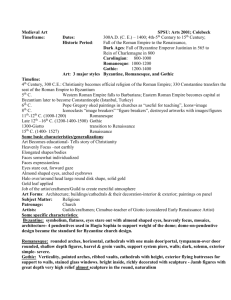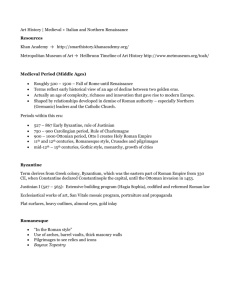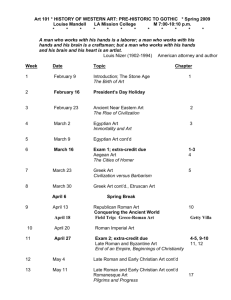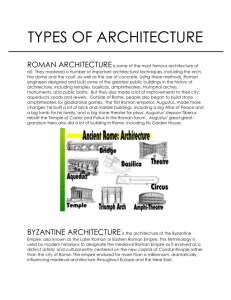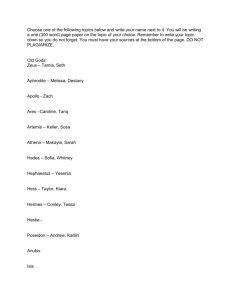AP ART HISTORY MIDTERM REVIEW
advertisement
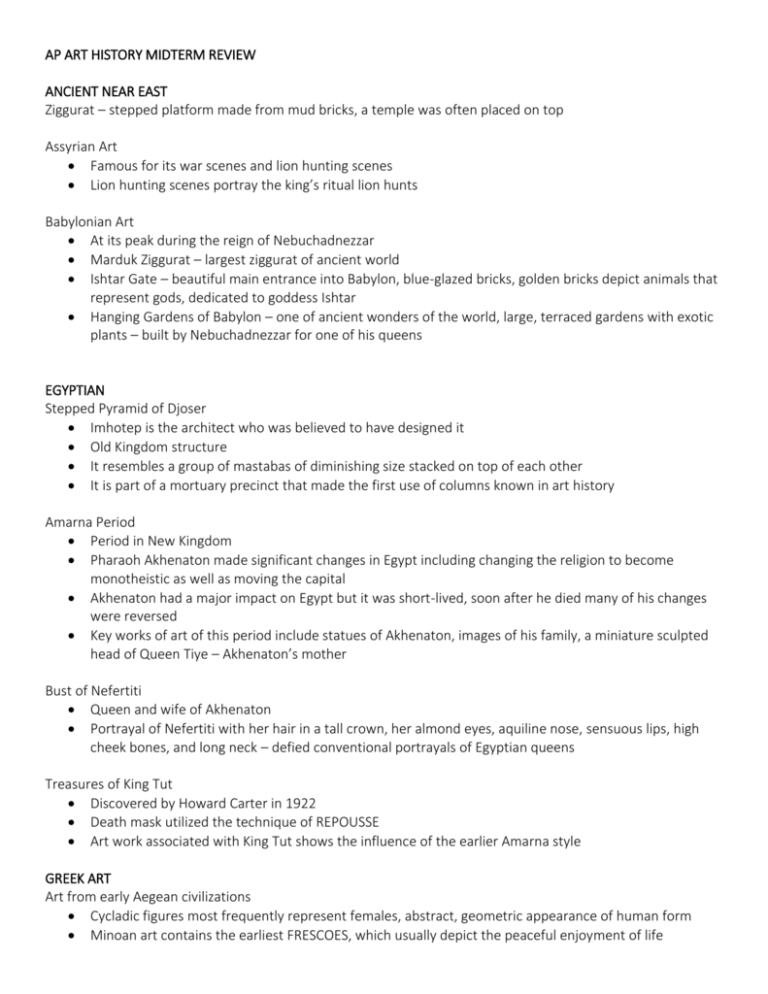
AP ART HISTORY MIDTERM REVIEW ANCIENT NEAR EAST Ziggurat – stepped platform made from mud bricks, a temple was often placed on top Assyrian Art Famous for its war scenes and lion hunting scenes Lion hunting scenes portray the king’s ritual lion hunts Babylonian Art At its peak during the reign of Nebuchadnezzar Marduk Ziggurat – largest ziggurat of ancient world Ishtar Gate – beautiful main entrance into Babylon, blue-glazed bricks, golden bricks depict animals that represent gods, dedicated to goddess Ishtar Hanging Gardens of Babylon – one of ancient wonders of the world, large, terraced gardens with exotic plants – built by Nebuchadnezzar for one of his queens EGYPTIAN Stepped Pyramid of Djoser Imhotep is the architect who was believed to have designed it Old Kingdom structure It resembles a group of mastabas of diminishing size stacked on top of each other It is part of a mortuary precinct that made the first use of columns known in art history Amarna Period Period in New Kingdom Pharaoh Akhenaton made significant changes in Egypt including changing the religion to become monotheistic as well as moving the capital Akhenaton had a major impact on Egypt but it was short-lived, soon after he died many of his changes were reversed Key works of art of this period include statues of Akhenaton, images of his family, a miniature sculpted head of Queen Tiye – Akhenaton’s mother Bust of Nefertiti Queen and wife of Akhenaton Portrayal of Nefertiti with her hair in a tall crown, her almond eyes, aquiline nose, sensuous lips, high cheek bones, and long neck – defied conventional portrayals of Egyptian queens Treasures of King Tut Discovered by Howard Carter in 1922 Death mask utilized the technique of REPOUSSE Art work associated with King Tut shows the influence of the earlier Amarna style GREEK ART Art from early Aegean civilizations Cycladic figures most frequently represent females, abstract, geometric appearance of human form Minoan art contains the earliest FRESCOES, which usually depict the peaceful enjoyment of life Minoan art was discovered by Arthur Evans at the Palace of Knossos, Crete Mycenaean art was discovered by Heinrich Schliemann Mycenaean used cyclopean masonry (large stones) and created the CORBELLED ARCH – in which each level of blocks extend from the lower course until the upper blocks meet at the top Important Mycenaean figures were buried in THOLOI – bee-hive shaped tombs Death mask of a Mycenaean king utilized the technique of REPOUSSE Archaic Greek vases Black figure vases came first and feature black figures on a red background Red figure vases came next and feature red figures on black background, allow artist to reveal more naturalism and detail in human form Kouros Statue of a young man Created during the Archaic period Served as a grave marker Reveals a strong Egyptian influence in its rigid, upright posture Different because it is NUDE – reveals how Greeks took pride in the human form Kore – statue of a female often in the role of a goddess Classical sculptors and their key works Polykleitos and Doryphoros (aka Canon) Praxiteles and Aphrodite of Knidos Lysippos and Apoxyomenos (Scraper) Seated Boxer Hellenistic style which is summarized by the E’s – Emotional, Expressionistic, Erotic, and Everyday people Boxer appears old and defeated, not heroic, which draws sympathy from the viewer Has qualities in common with Old Woman – statue from Met Laocoon and his sons Attributed to Hegesandros, Athanodoros, and Polydorus of Rhodes Shows intense emotion and suffering Depicts the death of a Trojan priest and his sons ROMAN ART Pantheon Roman temple dedicated to all the gods Commissioned by Emperor Hadrian Contains a dome resting on a drum (ROTUNDA), PORTICO, and OCULUS Ceiling contains COFFERS – recessed panels Made from concrete and blocks Arch of Titus Part of a triumphal arch intended for glorifying Titus Famous scene showing the conquest of Jerusalem Roman soldiers plunder the Temple and steal a menorah Demonstrates a Roman interest in recording and glorifying major events Still-life of peaches and vase of water Fresco painting with great naturalism On the wall of a Roman villa (country home) From Herculaneum, city near Pompeii, that was buried during the eruption of Mount Vesuvius Dates to first century CE BYZANTINE ART Justinian Mosaic Shows Justinian as a powerful emperor surrounded by his attendants Justinian holds the paten – container with the holy bread Justinian is closely connected with Christ because he holds an implement for the Eucharist and his soldier has the XP (chi-rho) monogram on his shield Shows the “Byzantine Aesthetic” – F, F, F, G – Flat, Floating, Frontal, and Golden background Christ as Good Shepherd mosaic from Mausoleum of Galla Placidia Shows Christ in the center surrounded by sheep Contains interest in naturalism and depth Harbaville Triptych Famous IVORY TRIPTYCH Purpose is devotional Most Byzantine small devotional objects are made from ivory Panels include Christ flanked by Mary and John the Baptist, some of the apostles, and saints ISLAMIC ART Mosques Qibla – wall in the mosque that directs the faithful toward Mecca Hypostyle prayer hall – enclosed hall with many columns used for prayer and communal gathering Minaret – tower used to call people to pray No images of people or animals are allowed inside – Therefore, mosques do not contain narrative art Taj Mahal Mausoleum built in Agra, India that contains Islamic architectural motifs (dome, minarets) – remember that it is a MAUSOLEUM (Taj Mahal was the wife of the Mogul emperor Shah Jahan) Ancient Near Eastern Art Stele of the Law Code of Hammurabi STELE – large stone marker of an important event, popular in ancient Near Eastern art Top of stele includes a BAS RELIEF of Hammurabi appearing before the god Shamash Shamash is depicted in HIERARCHICAL SCALE and gives Hammurabi symbols of the right to rule his people EARLY MEDIEVAL ART Art of Warrior Lords Merovingian fibula Small, portable Abstract animal imagery Highly decorative, most available space filled in with CLOISONNE Hiberno-Saxon Art Best known for intricate illuminated manuscripts Illuminated manuscripts renowned for their intricate interlace designs that fill all the available space on the page Monks produced the illuminated manuscripts in scriptoria (workshops in monasteries) Examples – Book of Kells and Lindisfarne Gospels Example: Lindisfarne Gospels Famous CARPET PAGE – contains interlace, a Celtic cross, and abstract animal imagery TEMPERA on VELLUM Carolingian Art Art from the reign of Charlemagne Famous for trying to restore the glory of the Roman Empire (Charlemagne was the Holy Roman Emperor Palatine Chapel – special chapel built for Charlemagne connected to his palace in Aachen Central plan with an interior dome Makes extensive use of round arches, piers, and Corinthian columns Design influenced by the Byzantine church in Ravenna – San Vitale Illuminated Manuscripts Illuminated manuscripts became very popular during the Carolingian Revival – fulfilled Charlemagne’s agenda of spreading literacy and reviving culture Examples include Coronation Gospels and Ebbo Gospels Ebbo Gospel’s page with Saint Matthew – linear and energetic use of line that was common in Carolingian painting Ottonian Art Gero’s Crucifix Commissioned by Archbishop Gero for Cologne Cathedral, Germany Shows Christ’s intense suffering – head hangs with streaks of blood, arms stretched from their sockets Life-size Christ, wood sculpture that is painted and gilded with gold Also serves as a reliquary Bishop Bernward commissioned bronze doors for Saint Michael’s at Hildesheim Saint Michael’s at Hildesheim contains a double transept and entrances are at the side (side aisles function as a NARTHEX ROMANESQUE ART 1000 – 1150 Time of religious pilgrimages to see holy relics throughout Europe Santiago de Compostela – pilgrimage church that was the final stop on the pilgrimage trail Saint-Sernin Pilgrimage church Cruciform shape Nave ceiling supported by BARREL VAULT – a long, straight vault in the shape of round arches AMBULATORY – extra walkway around the apse in which relics were displayed – this feature was added to Romanesque churches so that pilgrims did not interrupt daily services CROSSING SQUARE – where nave and transept intersect, main unit used to derive church dimensions such as the size of NAVE BAYS and SIDE AISLE BAYS BAYS – three dimensional modules in a building Portal – entrance to a church Tympanum Semi-circular lunette over the lintel in the portal Romanesque tympanums often show scenes of Last Judgment Tympanum of Saint-Lazare at Autun Scene of Last Judgment Signed by the sculptor GISLEBERTUS Cathedral Complex at Pisa Leaning Tower of Pisa is really a CAMPANILE for the complex Cathedral itself is Romanesque in style Baptistery is Romanesque but contains Gothic features in its upper portion Baptistery also contains Pisano’s pulpit GOTHIC ART 1150 – 1400 Height and light Abbot Suger created the style in his remodeling of Saint-Denis Pointed arches Large areas of stained-glass windows – filters light into many colors which symbolized the heavenly light of the “new Jerusalem” Flying buttresses Three – part nave elevation – Nave arcade, TRIFORIUM, and CLERESTORY Chartres Built during the High Gothic period Contains key Gothic features – large areas of stained-glass, rose windows, flying buttresses, soaring verticality Royal Portal – western façade of Chartres contains jamb column sculptures of kings and queens of Old Testament, early Gothic sculpture barely projects from the building Later Gothic sculpture Increasing naturalism in body proportions and drapery Gothic S-curve enhances a sense of naturalism Becomes more independent of surrounding architecture PRECURSORS OF THE RENAISSANCE Early 1300’s Art that began to show glimpses of the Renaissance to come Greater interest in naturalism, creating the illusion of depth Pisano’s Pulpit at Pisa 1260 Pulpits marble panels show scenes from New Testament Full-figured bodies and interest in drapery resemble Roman figures from sarcophagi Arena Chapel Contains landmark FRESCO cycle painted by GIOTTO GIOTTO’S painting style shows a much greater interest in naturalism Figures are very full, good use of shading and light to make the figures look sculpturesque REAL PEOPLE, REAL SPACE, and REAL HUMAN EMOTION Duccio Contemporary of Giotto Also renowned for including greater naturalism in his paintings and a sense of depth Painted La Maesta – altarpiece painted for Siena Cathedral La Maesta was strongly influenced by Byzantine art but shows Duccio’s interest in the “new naturalism” La Maesta is an ALTARPIECE, the purpose of which is devotional PREDELLA – wooden base of an altarpiece often filled with additional panel paintings Other Sienese Painters Simone Martini – famous for starting what will become the INTERNATIONAL STYLE – not as naturalistic as Duccio’s work, depicts long processions of aristocrats wearing colorful and intricately decorated costumes Ambrogio Lorenzetti – famous for painting the Effects of Good and Bad Government in Siena’s Palazzo Pubblico Palazzo Pubblico City hall of Siena Contains Lorenzetti’s Effects of Good and Bad Government Contains a CAMPANILE – bell tower that is in the Gothic style EARLY RENAISSANCE Botticelli’s Birth of Venus Painted for the Medici family Tempera on canvas First large-scale painting with mythological theme since Classical Civilization, noteworthy also because of its nudity Expresses ideal beauty based on Classical canon, Based on a Neo-Platonist poem by Poliziano Paintings like Birth of Venus were denounced by FRA SAVONAROLA, a fiery Florentine priest who disapproved the rise of humanism because of its pagan elements and sensuous themes Donatello Great 15th century sculptor of Florence Commissioned by Medici to create a David, it was placed in their palace courtyard in Florence David was the first large free-standing nude since classical civilization David stands in contrapposto and has a highly developed sense of naturalism David displays a classical calm despite having just killed the giant Goliath Saint Mark – statue of the Evangelist, highly developed naturalism, contrapposto, commissioned by the wool workers guild, decorated the niche of Or San Michele church in Florence Other key points: Michelangelo’s figures in both in sculpture and painting were influenced by Classical statues such as LAOCOON (Hellenistic) Tetrarchs From the late Roman period Portraits of four Roman emperors sharing power in the Late Empire The Tetrarchs are depicted as anonymous and equal partners together (style of government in the late Roman Empire) ruling Roman painting Roman frescoes such as Still Life with Peaches and Water were influenced by Hellenistic Greek paintings which no longer exist We know this because ancient historians wrote of great Greek painters such as Apelles Greek Theater at Epidauros vs. Roman Amphitheater (ex. Colosseum) Greek theaters are semi-circular, open at one side (where the stage would be), and blend in harmoniously with their surroundings (consider the Greek style of government and the concept of freedom of movement with the city-states) Roman amphitheaters are oval, closed structures intended for public spectacles such as gladiator contests. Like the Roman Empire’s method of government, the amphitheater was closed to contain people, controlling them, and distract them with interesting attractions. Roman architecture was used to stamp the glory of Rome on its surroundings and does not blend in harmoniously with its surroundings. Greek theaters were used to show plays during religious festivals especially those dedicated to Dionysus The different levels of the Colosseum, a Roman amphitheater, are decorated with round arches and engaged columns that follow different architectural orders – Tuscan-Doric at the lowest level, Ionic in the middle, and Corinthian in the top two levels. Colosseum contains concrete and stone construction with corridors of barrel and groin vaults to easily transport people Greek architecture Parthenon is a Doric temple on the Athenian Acropolis but contains a continuous Ionic-style frieze on its interior The first Ionic temple built on the Acropolis was the Temple of Athena Nike Iconoclasm Occurred in Byzantine art, movement that banned and destroyed icons for over 100 years Had a major impact on Byzantine art It eventually ended, and icons began to be painted again Bayeux Tapestry Long linen strip (over 200 feet long) with scenes embroidered in wool Commemorates the Norman conquest of England (remember William the Conqueror and the Battle of Hastings – 1066) Example of a narrative – uses the Medieval technique of continuous narration (the same figure may be seen several times)
